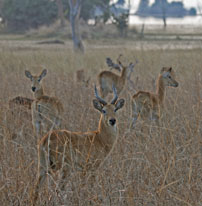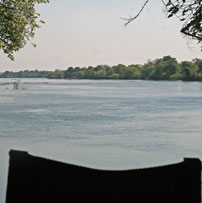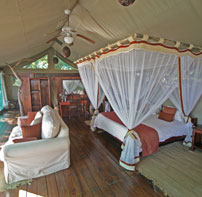Landing into Lusaka recently reminded me of my first visit to Zambia in the mid-1980’s. The Kenneth Kaunda International Airport is a simple 70’s building, accessed by a walk (no travellators or coaches here) along the apron from the stairs of the aircraft in the still, slightly chilly, air of a glorious mid-winters day.
Despite a coffee vendor selling more than a ‘half decent’ cup of latte, and a cosmetic change to the access to the international check-in area, little has changed and so I should not have been surprised that when I landed on an airstrip in the Kafue National Park some 2 hours later, I felt as if I were travelling to a new, unexplored part of rural Africa.
Kafue is huge, until recently the l argest National Park on the continent. In the south and central areas, it is dominated by miombo woodland which stretches out from the banks of the impressive Kafue River and its tributaries. In the north-west, the miombo gives way to the Busanga floodplains, inundated by waters of the Lufupa and largely inaccessible for much of the year. The terrain, as you can imagine, is rather flat and it has its fair share of tsetse fly, the saviour of wilderness Africa but menace to many a safari traveller. Not much going for it then?
argest National Park on the continent. In the south and central areas, it is dominated by miombo woodland which stretches out from the banks of the impressive Kafue River and its tributaries. In the north-west, the miombo gives way to the Busanga floodplains, inundated by waters of the Lufupa and largely inaccessible for much of the year. The terrain, as you can imagine, is rather flat and it has its fair share of tsetse fly, the saviour of wilderness Africa but menace to many a safari traveller. Not much going for it then?
Not in the slightest. I travelled extensively through the park staying at six different properties, none with more than 24 beds and each with its own old-style safari  character. Game-viewing, although a bit challenging in late June (a bit too early to visit), was certainly exclusive – the great thing is that most of the lodges are really spread out – but over the week I did see a good number of elephant, lion, hippo, and buffalo, and range of antelope species including sizeable herds of both sable and roan. The birdlife was as usual superb, and even in mid-winter I managed 138 species including at least seven African finfoot. The Kafue River itself is beautiful and alluring – you don’t get the immensity of the Zambezi or Rufiji, but it’s more than large enough to be captivating as you travel along by boat, pontoon, or canoe.
character. Game-viewing, although a bit challenging in late June (a bit too early to visit), was certainly exclusive – the great thing is that most of the lodges are really spread out – but over the week I did see a good number of elephant, lion, hippo, and buffalo, and range of antelope species including sizeable herds of both sable and roan. The birdlife was as usual superb, and even in mid-winter I managed 138 species including at least seven African finfoot. The Kafue River itself is beautiful and alluring – you don’t get the immensity of the Zambezi or Rufiji, but it’s more than large enough to be captivating as you travel along by boat, pontoon, or canoe.
Kafue will not rival The Luangwa Valley or Lower Zambezi National Park for sheer numbers of animals, but it does offer the safari enthusiast the chance to see an area of Africa reminiscent of the 70’s and 80’s, something quite difficult to find in these modern times.
 The last few days of my trip were spent exploring the Lower Zambezi National Park, staying and properties both inside the park and in the adjoining GMA (game management area). Properties here are, overall, probably a notch up on most of those in the Kafue – they are after all more used to having a lot of foreign guests. Game-viewing was excellent, but the real attraction here is the opportunity to do such a wide range of activities. Canoe and boat the river, fish the inlets and river tributaries, walk through the park or enjoy both day and night game drives by open safari vehicle.
The last few days of my trip were spent exploring the Lower Zambezi National Park, staying and properties both inside the park and in the adjoining GMA (game management area). Properties here are, overall, probably a notch up on most of those in the Kafue – they are after all more used to having a lot of foreign guests. Game-viewing was excellent, but the real attraction here is the opportunity to do such a wide range of activities. Canoe and boat the river, fish the inlets and river tributaries, walk through the park or enjoy both day and night game drives by open safari vehicle.
